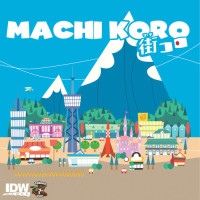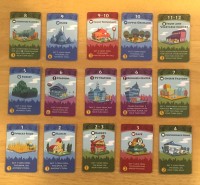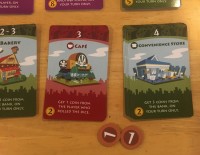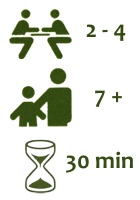Machi Koro – Build your city in style

If you were Mayor of a newly established city, what would you build first?
That’s the premise behind the game we’re reviewing today – Machi Koro.
Machi Koro is a quick family game where players compete to build their cities to become the largest in the region.
Players do this by rolling dice, collecting money, buying establishments, and ultimately building 4 landmarks. Because the first player to complete all 4 of their landmarks wins the game.
City-Building with Dice
A couple weeks ago we reviewed another game that’s all about using dice to build something grand – Roll For The Galaxy.
While the goal may seem similar – build the best empire vs. build the best city – the game play is very different.
In Roll For The Galaxy, players roll lots of dice to develop cool technologies and settle planets to build the best empire. It’s quite involved with lots of symbols, tiles, and most of all – lots of colored dice.

Machi Koro, on the other hand, lies on the opposite side of the spectrum. It’s a very straightforward and simple game to play and only involves 2 dice!
In Machi Koro, players share the dice and take turns rolling and buying establishments. And because it’s so straightforward, turns go by very quickly.
How about a quick rundown of the game play…
How to Play Machi Koro
To start, players set up the marketplace of 15 different Establishments. They create stacks of these matching cards in the center of the table arranged in order of their dice roll requirements (the number at the top of the cards). These cards are Establishments that players will be able to purchase throughout the game to expand their city.
Each player begins the game with 2 establishments (cards) – a Wheat Field and a Bakery.

They also receive cards representing their 4 Landmarks and 3 coins. They place their Landmarks facedown to represent “Under Construction” and they’re ready to go.
On a player’s turn, they’ll do 3 things:
- Roll
- Earn Income
- Construction
1. ROLL
The first thing a player does on their turn is roll the dice. At the start of the game, they’ll only be able to roll 1 die. Later, once they’ve built their Train Station landmark, the player may choose to roll either one or two dice.
2. EARN INCOME
Based on the result of the die/dice roll, players will earn income. It’s also possible to earn income on another player’s turn.

To determine the income generated, players look at the resulting number of pips on the dice rolled and compare it to the number at the top of their establishments.
For example, if a “2” or “3” is rolled, then a player’s starting Bakery goes to work. Each Bakery the current player has in their city will earn them 1 coin.
Establishments come in 4 different types. Each type earns income in different ways.
- Blue – Get income from the bank, during anyone’s turn.
- Green – Get income from the bank, during their turn only.
- Red – Take coins from the person who rolled the die.
- Purple – Get income from all players, during their turn only.
For example, if a 1 is rolled by any player, then all Wheat Fields (blue card) are activated. Regardless of who rolled the 1, every Wheat Field will generate 1 coin for the owner.

As another example, if a player has a Café (red card) in their city and another player rolls a 3, the player with the Café will take 1 coin from the player who rolled the 3.
If a player has more than one type of an establishment in their city, the effects are multiplied.
For example, if a player has 3 Bakeries in their city, they’ll earn 3 coins when they roll a 2 or 3.
If a roll activates multiple types of establishments (like a roll of 2, 3, 9, or 10), they are activated in the following order: Red, Green & Blue, Purple. Thus all the “take from the person who rolled” establishments go first. Then the production cards activate. Finally the “take from all players” establishments activate.
3. CONSTRUCTION

After earning income, the current player can pay to construct one building from the market or one of their Landmarks.
The cost of each Establishment or Landmark is located in the bottom-left corner of the card.
After paying coins to the bank, the player takes the purchased card from the central marketplace and adds it to their growing city. If they pay for one of their Landmark cards, they simply turn it over to the colored side and can begin using the associated benefit.
Players can have multiple types of each establishment except for those with a tower symbol (purple cards and landmarks).
Once they’ve constructed an Establishment or Landmark (or elected not to), their turn is over and play continues to the next player.
The game ends as soon as one player completes the purchase of their 4th Landmark. That player wins the game!
Can the whole family enjoy Machi Koro?
Machi Koro is a game that everyone in the family can enjoy playing together.
The rules are very simple to understand and turns are rather quick – roll, get money, buy a card.
Once your kids can recognize written numbers, they can enjoy playing. And even though there is text on every card, the colored cards and iconography are so memorable that we don’t think kids have to know how to read to enjoy playing.

Since the result of the dice rolls are the main driver in the game, Machi Koro is very luck-dependent. However, it doesn’t mean the game is devoid of strategy.
By having options in which establishments to construct, the choices each player makes will definitely affect the outcome of the game.
Do you spend your money as soon as you get it? Or do you save up to buy something bigger?
When is the right time to start completing Landmarks and which ones do you complete first?
Do you want to just earn money from your own rolls (buy green) or the rolls of other players (buy blue)?
Or do you want to steal money from others on their rolls (buy red or purple)?
That being said, if you’re looking for deep strategy in a dice rolling game, this isn’t it.
Machi Koro hits the sweet spot in the family board game market with its balance of fun, lucky dice rolling odds with a bit of light strategy.
Build Your City on Rock n’ Roll
Well, there aren’t really any rocks in Machi Koro, but there’s definitely a lot of rolling.
When I first saw the setup of Machi Koro, it reminded me of one of my favorite card games – Dominion.
Granted Dominion is a deck-building game and Machi Koro isn’t about building your deck of cards. But there are still some similarities.

In Dominion, there’s a central market of cards from which players can purchase to give them more abilities later in the game. In a like manner, buying cards from the marketplace in Machi Koro will add to your capabilities later in the game.
However, one of the major differences from Dominion is that in Machi Koro which cards are activated depends on the fate of the dice rolls. In Dominion, the luck comes in the form of which cards you draw into your hand on a turn.
But in both cases, you’re still buying cards that will grant you powers as you progress.
That being said, the feeling I get while playing Machi Koro is completely different than Dominion.
In Dominion, I like planning which cards I’ll buy to hope they can combo together for an awesome turn later.
In Machi Koro, it’s not really about combos, but rather playing the odds on the number of pips that will show up on the dice and making sure I have the right establishments in the right quantity to take advantage of it.
But at the same time, it’s such a light game that I don’t want to break out mathematical formulas to discover which statistical probability will yield the best results.
I just want to have a bit of fun with my family. And Machi Koro delivers on that.
How does Machi Koro score on our “Let’s Play Again” game meter?
 Machi Koro scores well on our “let’s play again” game meter. It may not top the charts on the most-requested game in our collection. But it’s one that will definitely stay on our game shelves.
Machi Koro scores well on our “let’s play again” game meter. It may not top the charts on the most-requested game in our collection. But it’s one that will definitely stay on our game shelves.
We haven’t yet tried any of the Machi Koro expansions, but they look very tempting. We’ve loved adding expansions for Dominion and if the expansions for Machi Koro continue to inject new twists to the options available in the game, then count us in.
Thanks IDW for a fun family game in Machi Koro!



My family is a little torn on Machi Kori. My wife and I enjoy it as does my oldest son (16). My middle son (14) enjoys it but he gets very stressed if his numbers aren’t coming up and he can’t build or he has no idea what to buy (even with prodding advice from his parents). My daughter (12) doesn’t like it much at all.
With 5 of us, we weren’t able to play the base game…so we picked up the Harbor expansion. This expansion adds a 5th set of base cards and we “could” have played standard rules with those cards, but we added in the expansion rules as well which were very interesting.
Rather than always having the same set of buildings available, you shuffle up the entire deck (the expansion includes some new buildings) and deal out until you have 10 unique structures to purchase. You then play the game as normal and when one of those 10 available buildings is depleted, you deal out more cards to see if you get another available building (you may add to existing building piles while searching for another unique structure). This helped even out the game a little bit since my wife, oldest son and I had our strategies where we basically “rushed” for certain buildings and with this randomization, it makes it harder to get exactly what you want. At the same time, it made things a little more frustrating for my younger son as he was sometimes even more stumped as to what to buy.
Overall I do still really enjoy this and will keep bringing it out with the family.
That’s a couple great reasons to pick up the Harbor expansion, Chris.
I like the idea of mixing it up so you can’t head down the same path every time.
And I’m looking forward to trying out the Harbor expansion at SaltCon in a few weeks.